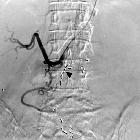zollinger-ellison syndrome
Zollinger-Ellison syndrome (ZES) is a clinical syndrome that occurs secondary to gastrinoma.
Clinical presentation
Diagnosis of ZES is often delayed by 5-7 years after the onset of symptoms .
Pathology
Gastrinomas are usually multiple and typically located in the duodenum (more common) or pancreas (less common). These tumors secrete gastrin that results in hypersecretion of gastric acid, which in turn results in diarrhea, gastritis, severe gastro-esophageal reflux disease and peptic ulcer disease .
Markers
- increased gastrin levels in fasting patients (but not specific, and some data suggest that clinical assays may be unreliable )
Associations
- multiple endocrine neoplasia (MEN) type 1: ZES occurs when gastrinoma is functional
Radiographic features
Fluoroscopy
On double-contrast upper gastrointestinal studies the following features may be seen :
- thickened rugal folds
- multinodular gastric contour
- erosions and ulcers, especially in atypical locations
- barium may be diluted by the high volume of fluid in the stomach
CT
- negative contrast may be used to distend the stomach
- thickened rugal folds
- multiple gastric nodules/masses
Treatment and prognosis
Surgery plays a vital role . Death from complications of ZES (e.g. perforation, hemorrhage) can occur.
History and etymology
It is named after Robert M. Zollinger and Edwin H. Ellison, who in April 1956 described two cases of severe, multifocal ulcerative lesions of the proximal gastrointestinal tract, which were remittent, refractory to surgery and associated with tumors in the adjacent pancreas .
Differential diagnosis
Possible differential considerations include:
- gastritis from other causes, e.g. H. pylori infection, hypertrophic gastritis
- gastric lymphoma
- gastric outlet obstruction
- previous vagotomy
- pernicious anemia
Siehe auch:

 Assoziationen und Differentialdiagnosen zu Zollinger–Ellison syndrome:
Assoziationen und Differentialdiagnosen zu Zollinger–Ellison syndrome:


